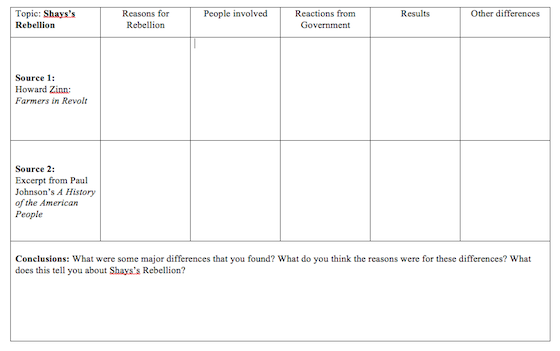A few years I wouldn’t have been
able to admit this aloud, but as I get older, I get bolder, so here goes...
Hi.
My name is Tracy and I hate the
KWL.
There. I’ve said it. (Is that
edu-blasphemy?)
All the reading trainings in the
world, from college courses to CRISS to CAR_PD seem to love the KWL. And I
honestly can’t stand it.
If you don’t remember the KWL
(how can you forget it?) it is a three-column chart (or organizer) that asks
kids what they Know, what they Want to know and what they Learned
about a particular topic. See? K-W-L.
And no matter how I tried it, in
my class, I always had a handful of kids who answered those three questions
with “nothing, nothing, nothing.”
What do you know about the Civil
War? Nothing.
What do you want to know about
the Civil War? Nothing.
What did you learn about the
Civil War? Nothing.
No matter how I tried to persuade
my students, with grade threats or learning promises, no matter how many zeros
I gave for those non-answers, no matter how engaging the lessons, I always had
kids who seemed to delight in frustrating me by giving those answers. And if
I’m honest, the kids who answered “nothing” were the ones I was often
especially targeting with my lesson anyway. The advanced kids did fine with or
without that KWL. The struggling kids tuned me out as soon as they saw a KWL.
To be fair, some of my kids
(especially my ESOL immigrant kids) really didn’t know anything about
the American Civil War. They had never heard of it! They didn’t know enough
about it to even come up with a question or a “Want to know”.
It’s like asking me what I know
about balancing chemical equations. Nothing. What do I want to know
about balancing chemical equations? Nothing. What did I learn in
chemistry about balancing chemical equations? Nothing. (Apologies to my
high school chemistry teacher, who was really good. My ignorance of chemical
equations is my own fault.)
I don’t know. Maybe in the way
dogs smell fear, my students smelled teacher-apathy. I may very well have been
teaching the KWL wrong. It wouldn’t be the first time I messed up repeatedly. I
know plenty of really skilled teachers who swear by it.
But it never worked for me.
What I discovered instead is a
different reading strategy that takes that KWL idea and turns it around to make
it similar to what historians, social scientists, journalists, the common core
(or Florida Standards, now) and DBQs do.
Teach kids to use multiple
sources to come up with a conclusion. Try an I-Chart.

It’s not really an equal,
substitute-an-I-Chart-where-you-would-use-a-KWL kind of thing. You will have to
use it a slightly different way
An I-Chart has students use
multiple sources to come to conclusions. Again, like Common Core/Florida
Standards ask, students make conclusions based on those multiple sources.
How do we do that? I’m glad you
asked!
·
If you’re asking about the Civil War, first use something more
specific than the whole Civil War. Ask about Andersonville or Sherman’s March
to the Sea or the Emancipation Proclamation.
·
Next, give the kids several resources with which to examine that
topic. For the sake of movement and limited resources, feel free to make
“stations” where students consult a textbook at their desks, a primary source
in another area, a particular website on a student station, or an image on the
board or screen.
·
What did we learn from each site about Andersonville?
Students can fill in the I-Chart for the topic of Andersonville and then
...
and here’s the important Common
Core/Florida Standards/authentic historian part --
·
Kids summarize or conclude based on what they learned from the two
or three or four sources they just examined.
Why not have them just get it out
of the book? Or from their notes?
1.
First, as you know, our book is not always perfect.
2.
It’s also not healthy for us as citizens to get ALL of our
information from one place.
3.
It’s also teaching our students to synthesize.
4.
It’s also a lot like their AIR standardized test will look like
next year (AIR replacing FCAT or PARCC, in case your acronyms aren’t up to
date)
5.
Ahem...(*cough, cough*) That really IS what historians and
social scientists DO!
And here’s a pretty simple page
that explains what it’s about and how to use it. http://www.readwritethink.org/classroom-resources/printouts/chart-b-30775.html
Here's a teacher-adapted one

If you don’t hate KWLs, you might
still think about using the I-Chart as a variation, to take reading from
single-source to multi-source. To use two or three (or four?) sources to
examine a topic from multiple perspectives.
Try to project an image of
Andersonville, have kids examine a brief letter excerpt from an Andersonville
prisoner, and read a paragraph or two from their textbook. Have them complete
an I-Chart and see how more thorough their understanding of this topic is.
I bet they “get it” better with
an I-Chart than they do with a KWL chart. Just sayin’ :)
Do you know how to rock the KWL
in a more meaningful way? Can you tell me what I was doing wrong? Or do you
(secretly) hate it too? (It’s okay. I won’t tattle on you). Have you tried an
I-chart? How did it go?

No comments:
Post a Comment